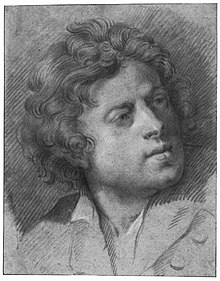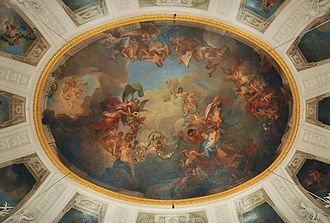Nicolas Guibal
Nicolas Guibal (born November 29, 1725 in Lunéville ; † November 3, 1784 in Stuttgart ) was the Württemberg court painter of French origin. The main works still preserved are the ceiling paintings in Solitude Castle and Monrepos Castle .
Parental home and education
Guibal was the son of the sculptor Barthélemy Guibal (1699–1757) from Nîmes . He first worked as a sculptor in the service of Duke Leopold of Lorraine in Lunéville and from 1733 for Stanislaus Leszczyński in Nancy and the surrounding area. The mother Marie-Catherine Barthélemy came from a wealthy local family.
He received his first suggestions in his father's studio. However, he decided to train as a painter and went to Nancy to Claude Charles, the former court painter of Leopold von Leopold von Lothringen. In 1740 he moved to Paris; from 1745 he enrolled there at the Académie des Beaux Arts with Charles Natoire .
life and work

In 1749 he was appointed to the Württemberg court by Duke Carl Eugen . He arranged court parties and created theatrical decorations. In 1750 the duke granted him 200 guilders for a trip to Rome. When the Duke himself traveled to Rome in 1753, Guibal presented him with several paintings. The Duke liked them; when he returned to Württemberg, he gave him an annual pension of 750 guilders for further training in Italy. The pictures that Guibal painted in Rome were lost, with the exception of one, in a fire in the New Stuttgart Palace in 1762. Only a copy of this picture has survived, as an engraving by a student from Karlsruhe. The antique painting shows the influence of Guido Reni and similarities with a picture by Anton Raphael Mengs , whom Guibal met during his stay in Rome.
In 1755, after his return from Italy, the Duke appointed him the first painter at the court, Peintre du Duc de Wurtemberg . In 1758 he completed the large ceiling painting in the stairwell of the New Palace, which was destroyed in the Second World War. In that year he was appointed a member of the imperial academy in Augsburg.
Guibal married Christine Regina Juliana Greber in 1759. The marriage had five children.
In 1760 he was awarded the title of gallery director and the rank of court chamber councilor, which brought him annual income of 500 guilders, half in cash and half in kind, as well as the right to be transported by two-horse wagon. In 1763, together with the court architect Philippe de La Guêpière , he took care of the interior fittings of the newly built lake house , which later became known as Monrepos . In the salon, he painted a scene from the Metamorphoses of Ovid . In the same year, the construction of Solitude Castle began . From the start of construction, Guibal created numerous designs, wall elevations, wall and door pieces. In 1766 and 1767, the two large ceiling paintings in Solitude Palace were finally completed: a resurrection scene in the chapel and an allegory of the country's prosperity brought about by the princely virtues in the main hall. The painter Adolf Friedrich Harper and a student of the Académie des Arts were available to help with this work. Sculptors and artisans followed his guidelines. The duke increased his salary to 2,000 guilders a year.
Around 1770 Guibal was known beyond the borders of Württemberg. On behalf of Elector Karl Theodor von der Pfalz, he painted the ceiling painting Aurora defeats the night in the bathhouse of Schwetzingen Palace - again reminiscent of Guido Reni in clear reference to his Aurora in Palazzo Rospigliosi in Rome. 1774–1776 he painted two altar paintings for the St. Ursenkathedrale in Solothurn , which he brought personally. In 1778 he stayed in Mannheim for some time, where he painted an apotheosis of the Elector Palatinate in the house of Baron Joseph Sebastian von Castell on Bedernau . This image was also lost in World War II. At the same time, an illustrated catalog of the Düsseldorf painting collection of Elector Johann Wilhelm was created , which is now in the Alte Pinakothek in Munich. Guibal designed the title page and a thematic etching for each of the six halls.
In 1780 he designed five ceiling paintings for the High Charles School, which he completed together with his students by 1782. Furthermore, in the last years of his life, he created a draft for a tribute painting for a Russian delegation in the New Palace, which Philipp Friedrich von Hetsch carried out, as well as plastic works in Stuttgart, Schwäbisch Hall, Hohenheim and elsewhere. In 1783 he traveled to Paris to deliver his eulogy of Poussin, which was awarded by the Royal Academy of Sciences and Arts in Rouen .
However, by the late 1770s, his health had deteriorated. In 1781 he had to go to Strasbourg for a cure because of frequent, severe seizures. The doctors diagnosed poisoning from paints containing heavy metals . Nicolas Guibal died on November 3, 1784. The burial took place on November 5, 1784 in the Catholic parish of Hofen am Neckar .
Adolf Friedrich Harper was appointed his successor.
reception
With his formal language and his allegorical visual statements, Guibal was a late representative of the baroque . He was highly valued by his contemporaries. For example, the poet Christian Daniel Schubart wrote an eulogy for him, and many of his students kept loyal memories of him. Yet, barely twenty years after his death, he was forgotten because his art was now considered out of date. Shortly after 1800, court architect Nikolaus Friedrich von Thouret had decorations by Guibal and Philippe de La Guêpière smashed in Monrepos Castle and replaced with Empire- style decorations . He was now considered an eclecticist , among his posthumous critics is Johann Wolfgang von Goethe , who accused him of a lack of seriousness and a lack of understanding of the "well-understood drawing of beautiful, balanced forms". As early as 1809 the painter Eberhard Wächter and the copper engraver Friedrich August Seyffer searched in vain for his grave.
His work suffered heavy losses in the Second World War, when most of his monumental paintings as well as many panel paintings and drawings were destroyed.
Act as a teacher
From 1761 to 1784 Nicolas Guibal taught at the Académie des Arts and at the Hohen Karlsschule in Stuttgart . His students include Johann Heinrich Dannecker , Reinhard Ferdinand Heinrich Fischer , Heinrich Friedrich Füger , Philipp Friedrich von Hetsch , Joseph Nicolaus Peroux , Ludovike Simanowiz , Nikolaus Friedrich von Thouret among others.
literature
- August Wintterlin: Guibal, Nicolas . In: Allgemeine Deutsche Biographie (ADB). Volume 10, Duncker & Humblot, Leipzig 1879, pp. 102-104.
- Max Schefold: Guibal, Nicolas. In: New German Biography (NDB). Volume 7, Duncker & Humblot, Berlin 1966, ISBN 3-428-00188-5 , p. 296 f. ( Digitized version ).
- Michael Semff , Wolfgang Uhlig: Nicolas Guibal. Exhibition catalog Staatsgalerie Stuttgart 1989
Web links
| personal data | |
|---|---|
| SURNAME | Guibal, Nicolas |
| BRIEF DESCRIPTION | Württemberg court painter of French origin |
| DATE OF BIRTH | November 29, 1725 |
| PLACE OF BIRTH | Luneville |
| DATE OF DEATH | November 3, 1784 |
| Place of death | Stuttgart |


